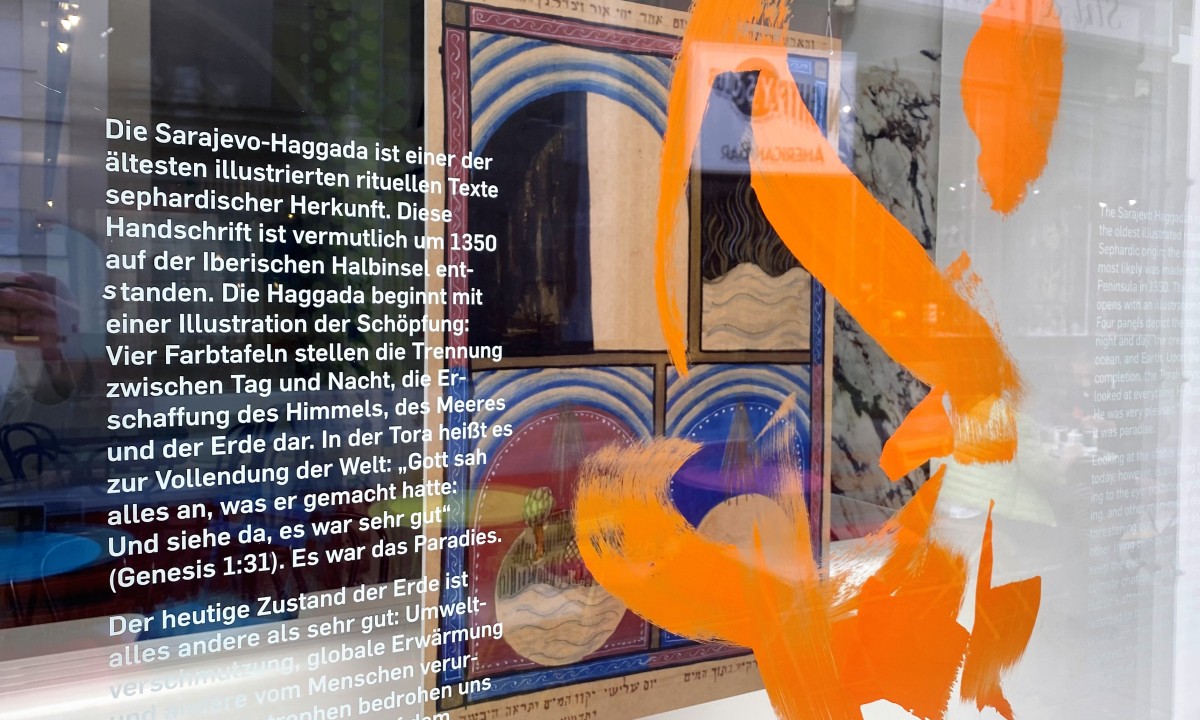The Sarajevo Haggadah ranks among the world’s oldest illustrated ritual texts of Sephardic origin; researchers estimate the manuscript was made in the Iberian Peninsula in 1350. Following the expulsion of Sephardic Jews from medieval Spain in 1492, the manuscript went on a mysterious journey throughout Europe, popping up in Venice in the seventeenth century and then eventually in Sarajevo upon its acquisition to the Bosnisch-hercegovinisches Landesmuseum (today the National Museum of Bosnia and Herzegovina) in 1894. Before it could be exhibited in Sarajevo, however, the text was examined at the Kunsthistorisches Museum in Vienna (Brooks, 2007). It was during this brief period that Max Fleischer, a prominent Viennese Jewish architect, drew copies of the Sarajevo Haggadah, which were later donated in 1900 to the Jewish Museum Vienna, founded in 1895.
The Haggadah opens with an illustration of Creation. Four panels depict the separation of night and day and the creation of sky, ocean, and Earth. Upon the world’s completion, the Bible says: “God looked at everything He had made, and He was very pleased,” (Genesis 1:31). It was paradise. Looking at the status of the Earth today, however, is anything but pleasing to the eye: pollution, global warming, and other man-made disasters are bringing us to the brink of extinction. Catastrophic climate change exacerbates the gap between the wealthy and poor, leading to an influx in socioeconomic issues, such as displacement and new migration flows, which in turn place pressure on social systems (Noonan & Rusu, 2022). Rising temperatures and increases in pollution directly impact our overall health and well-being, both physically and mentally. Rising temperatures and increases in pollution directly impact our overall health and well-being, both physically and mentally. Rising temperatures and increases in pollution directly impact our overall health and well-being, both physically and mentally (European Commission, 2023). Ultimately, the climate crisis affects us in all aspects of our lives.
To keep the ever-worsening climate catastrophe at the forefront of the public’s conscience, activist groups have resorted to brash tactics by targeting museum objects (CNBC, 2022). While such measures have been denounced, they did achieve their goal of gaining the media’s attention. Activists called out governments for their overwhelming support and investments toward the conservation of priceless artworks by Klimt, Van Gogh, Monet, among others, but appear to disregard the fact that without a livable, sustainable environment, there will be no more humans to create and enjoy culture.
Activist groups and demonstration movements like
Fridays for Future aim to hold governments accountable – particularly those of global superpowers – to enacting and following through with climate policy, especially to reach the goals outlined in the 2016 Paris Climate Agreement. Greenhouse gas emissions must be greatly reduced in Austria, the EU, and worldwide. Additionally, a driven commitment to an ecological shift in the global economy proves equally central to bringing about a vital turn in this global crisis and maintaining our world as depicted in the Sarajevo Haggadah.
Before adopting a nihilistic view, there are productive ways to take action at the individual level, even though the impact is relatively small within a global scope. It is important to keep in mind that every positive change, regardless of how small, meaningfully contributes to solving global issues. The Jewish Museum Vienna is doing what it can to run as green as possible. In July 2022 the JMW officially received the
Austrian Ecolabel as a green museum after undergoing a thorough assessment process, checking that sustainable practices are in place for exhibition programs and our daily workflow.
When installing exhibitions, for example, we ensure that we re-use as much material as possible, such as vitrines and plexiglass coverings from previous shows.
Since May 2023, the JMW is also a member of
Museums for Future, a non-profit organization dedicated to applying and adhering to the climate policies within the professional museum realm. Our commitment to ensure sustainability does not end here, however. All members of our community – citizens, museums, business, politicians – must work together to ensure that our world is habitable from the first to the last generation.

